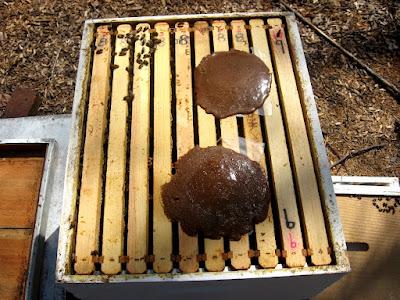Myrina
48 f
Sunny
To aid Mary I need to rob brood or bees from Myrina. I should have done it a week ago. The temperatures have been to low to crack into Myrina to do it. Today though was close enough.
As I opened her up the bees were calm but it didn't take long for the girls to come out in force against me. It's a pain but I love this colony. They clung to my sleeves and veil in clumps. Later I checked the shirt for stingers and found none. As usual their primary target was the smoker. I think I need to relocate this hive to a sunnier spot were they might act less defensively.
Intimidating but I am getting use to Myrina and her antics. So off comes the T-cover & the Vent box. I saw that many of her girls were hanging out on the dry sugar. Many more were on the bottom of the IC. The majority of bees were milling about on 5 to 6 frames of the top Deep. They were not clustered but the bees covered the frames top to bottom.
Unlike the previous inspection there were a few dead bees to be found. The hive & frames still looked clean though. Stores were good in the top box with only 3 empty frames. The bottom box has been depleted of it's reserves. I was able to look through each frame of both boxes. Population is good for this time of year but moderate overall.
Two high points. There is capped brood on frames 2, 3, & 4. A small patch on each. I did not see any uncapped brood but the bees were very thick on the frames. Also I finally found Queen Myrina herself.
 Queen Myrina
Queen Myrina
She was running around frame 3. I did not see her lay but it seemed like she was looking for something. This is the first time I've seen Myrina, or any queen from this colony. I love finding the queens. Always a thrill.
 Queen on Plasticell Frame
Queen on Plasticell Frame
I enjoyed a moment of watching her walk around then carefully put the frame aside to continue the inspection.
After finding the queen I felt better about which frames of bees to take out and give to Mary. Frames 5 & 6 picked the short straws. Each was 3/4's to 1/2 full of bees with enough capped honey. I slid them out and into a nuc. I replaced the frames with empty drawn out frames. These frames had clean fresh wax in them from last year. They were honey frames I culled to lure a swarm that never showed up. So I left them out in the yard last fall for the bees to pick through. They've not been used for brood yet. I read that a queen prefers fresh comb for laying eggs. I hope Myrina likes these.
Everything looked good down to the bottom board. All that was on it were cappings and dead bees. I gave it a good scraping and put everything back together.
After all this I threw on 2 pollen patties (Mega Bee) and added an entrance feeder to the hive. It's filled with a light 1:2 syrup now. Not medicated since I've not seen any problems. She got a good stirring today but it looks good for now.
-
Adding the 2 bee filled frames to Mary was easy. Pull out 3 frames, add the 2 frames donated by Myrina, then put back 1 of Mary's frames. No one gets mashed or ruffled. Drop & close. I honestly do not believe that Mary is going to live but it's worth it to try. She also got 2 pollen patties and she's had syrup since I moved her inside the garage. Although I did locate a feeder to the top of the hive. They've not yet found the lower entrance feeder. I hope they find one of them soon. I trust Myrina's bees will find what they need to survive.
Time will tell.






















